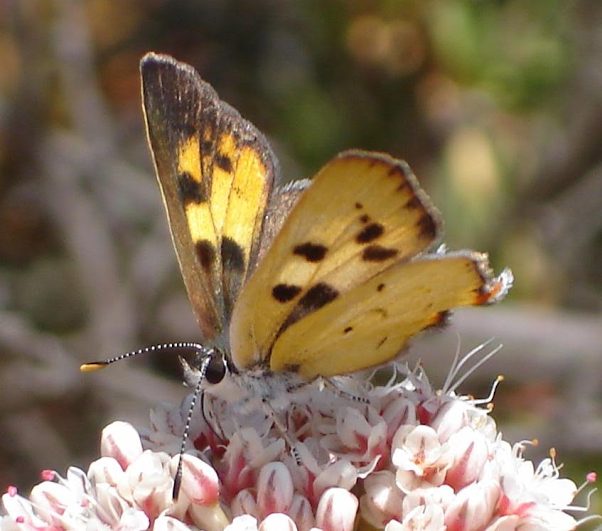This story first appeared in Center for Biological Diversity.
SAN DIEGO, Calif.— After nearly 30 years of petitions and lawsuits by the Center for Biological Diversity, the U.S. Fish and Wildlife Service today protected one of Southern California’s rarest butterflies, the Hermes copper butterfly, as a threatened species under the Endangered Species Act.
The agency also designated 35,000 acres of protected critical habitat in San Diego County. The habitat consists of three units: Lopez Canyon, which includes acreage within Los Peñasquitos Canyon Preserve; Miramar/Santee; and Southern San Diego.
“Without Endangered Species Act protection, the Hermes copper butterfly would surely be pushed into extinction by Southern California’s rampant development, wildfires driven by climate change and invasive plants,” said Ileene Anderson, a senior scientist at the Center. “I’m relieved to finally see this beautiful little butterfly and its habitat protected.”
The small, bright yellow-orange, spotted Hermes copper inhabits coastal sage scrub and chaparral habitats only in San Diego County and northern Baja. Its survival depends on dwindling patches of its host plant, the spiny redberry. Increasingly frequent and severe wildfires also ravage the butterfly’s primary source of nectar, the California buckwheat. Drought and development have also destroyed dozens of historic populations.
The Hermes copper occupied many San Diego coastal areas prior to urbanization, and still persists in some foothill and mountain areas up to 45 miles from the ocean. The butterfly declined from at least 57 historical populations to only 26 populations in a survey this year.
Devastating wildfires have increasingly burned through key Hermes copper habitat, putting an end to the tenuous existence of many remaining butterfly populations. For example, 2020’s Valley Fire came within just 2.5 miles of a core population of the butterfly. In today’s listing the Service warned that a single large wildfire could wipe out all remaining populations of the butterflies.
Background
Even by the time it was first described in the late 1920s, the Hermes copper was endangered by urban development. By 1980 staff at the San Diego Natural History Museum noted that San Diego’s rapid urban growth put the future of the butterfly in the hands of developers. The Fish and Wildlife Service first identified the butterfly as a potential candidate for Endangered Species Act protection in 1984.
The Center for Biological Diversity and San Diego Biodiversity Project filed formal petitions in 1991 and 2004 to protect the species. A lawsuit was required to force the Service to respond to the second petition, but the agency announced in 2006 that it would not protect the species, despite fires in 2003 that burned nearly 40% of the butterfly’s habitat.
The Center filed a second lawsuit in 2009, but the Service delayed protection by placing the butterfly back on the candidate list in 2011. So the Center sued a third time in May 2019, which finally forced the Service to propose a status of threatened in January 2020.
The Center for Biological Diversity is a national, nonprofit conservation organization with more than 1.7 million members and online activists dedicated to the protection of endangered species and wild places.
Banner image: Hermes copper butterfly. Photo by John Martin, USFWS. Image is available for media use.

